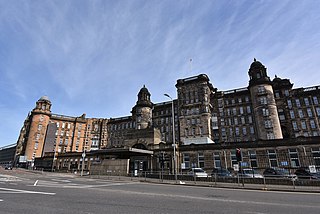
Rochdale is a town in Greater Manchester, England, and the administrative centre of the Metropolitan Borough of Rochdale. In the 2021 census the town had a population of 111,261, compared to 223,773 for the wider borough. Rochdale is in the foothills of the South Pennines and lies in the dale (valley) of the River Roch, 5 miles (8 km) northwest of Oldham and 10 miles (16 km) northeast of Manchester.

The Elsie Inglis Memorial Maternity Hospital was a maternity hospital in Holyrood, Edinburgh, Scotland.

Saint Mary's Hospital is a hospital in Manchester, England. It is part of Manchester University NHS Foundation Trust. Founded in 1790, St Mary's provides a range of inter-related services specifically for women and children. In 1986, St Mary's Sexual Assault Referral Centre was the first sexual assault referral centre (SARC) to open in the UK.

The Princess Royal Maternity Hospital is a maternity hospital in Glasgow, Scotland. It was founded as the Glasgow Lying-in Hospital and Dispensary in 1834 in Greyfriars Wynd, just off the city's High Street. It moved to St Andrew's Square in 1841, then to Rottenrow in 1860 and to the Glasgow Royal Infirmary site in 2001. It is managed by NHS Greater Glasgow and Clyde.

The Glasgow Royal Infirmary (GRI) is a large teaching hospital. With a capacity of around 1,000 beds, the hospital campus covers an area of around 8 hectares, and straddles the Townhead and Dennistoun districts on the north-eastern fringe of the city centre of Glasgow, Scotland. It is managed by NHS Greater Glasgow and Clyde. It was originally opened in 1794, with the present main building dating from 1914.

The IWK Health Centre is a major pediatric hospital and trauma centre in Halifax, Nova Scotia that provides care to maritime youth, children and women from Nova Scotia, New Brunswick, Prince Edward Island and beyond. The IWK is the largest facility in Atlantic Canada caring for children, youth and adolescents, and is the only Level 1 pediatric trauma centre east of Quebec.

The Royal Infirmary of Edinburgh (RIE), often known as the Edinburgh Royal Infirmary (ERI), was established in 1729 and is the oldest voluntary hospital in Scotland. The new buildings of 1879 were claimed to be the largest voluntary hospital in the United Kingdom, and later on, the Empire. The hospital moved to a new 900 bed site in 2003 in Little France. It is the site of clinical medicine teaching as well as a teaching hospital for the University of Edinburgh Medical School. In 1960, the first successful kidney transplant performed in the UK was at this hospital. In 1964, the world's first coronary care unit was established at the hospital. It is the only site for liver, pancreas and pancreatic islet cell transplantation and one of two sites for kidney transplantation in Scotland. In 2012, the Emergency Department had 113,000 patient attendances, the highest number in Scotland. It is managed by NHS Lothian.

Leeds General Infirmary, also known as the LGI, is a large teaching hospital based in the centre of Leeds, West Yorkshire, England, and is part of the Leeds Teaching Hospitals NHS Trust. Its previous name The General Infirmary at Leeds is still sometimes used.

The West Glasgow Ambulatory Care Hospital is a healthcare facility in Yorkhill, Glasgow. The new ambulatory care facility was created in December 2015 to house the remaining outpatient services and the minor injury unit previously housed at the Western Infirmary. It is managed by NHS Greater Glasgow and Clyde.

Stobhill Hospital is located in Springburn in the north of Glasgow, Scotland. It serves the population of North Glasgow and part of East Dunbartonshire. It is managed by NHS Greater Glasgow and Clyde.

The Edinburgh Royal Maternity and Simpson Memorial Pavilion was a maternity hospital in Lauriston, Edinburgh, Scotland. Its services have now been incorporated into the Royal Infirmary of Edinburgh at Little France.

Nottingham City Hospital is a large hospital located in Nottingham, England. It occupies a large 90-acre (360,000 m2) site on the ring road to the North of the city centre. It is composed of many buildings, most of which are joined by long corridors. Buildings include a leisure club, a Maggies Centre for people with cancer, and a patient hotel. It is managed by the Nottingham University Hospitals NHS Trust.

The Royal Victoria Infirmary (RVI) is a 673-bed tertiary referral hospital and research centre in Newcastle upon Tyne, England, with strong links to Newcastle University. The hospital is part of the Newcastle upon Tyne Hospitals NHS Foundation Trust and is a designated academic health science centre.

Ayrshire Central Hospital, also known as Irvine Central Hospital, is an NHS hospital in Irvine, North Ayrshire, Scotland. It is managed by NHS Ayrshire and Arran.

Tunbridge Wells Hospital is a large district general hospital in Pembury near Royal Tunbridge Wells, Kent, England, run by the Maidstone and Tunbridge Wells NHS Trust. The hospital is located on Tonbridge Road, around 0.5 kilometres (0.31 mi) to the north-west of Pembury, close to the A21 trunk road. It is surrounded by woodland on three sides.
Healthcare in Cumbria was the responsibility of Cumbria Clinical Commissioning Group until July 2022. On 1 April 2017 32 GP practices left the CCG and merged with Lancashire North CCG to form Morecambe Bay CCG.

The Queen Elizabeth University Hospital (QEUH) is a 1,677-bed acute hospital located in Govan, in the south-west of Glasgow, Scotland. The hospital is built on the site of the former Southern General Hospital and opened at the end of April 2015. The hospital comprises a 1,109-bed adult hospital, a 256-bed children's hospital and two major Emergency Departments; one for adults and one for children. There is also an Immediate Assessment Unit for local GPs and out-of-hours services, to send patients directly, without having to be processed through the Emergency Department.

Macclesfield District General Hospital is a health facility in Macclesfield, Cheshire. It is managed by the East Cheshire NHS Trust.

Birch Hill Hospital is a health facility in Wardle, Littleborough, near Rochdale, Greater Manchester. It was managed by Pennine Acute Hospitals NHS Trust when it was a general hospital. Parts of the hospital are now managed as a psychiatric hospital by Pennine Care. There is also the Floyd Unit which is a Neuro Rehabilitation Unit managed by Pennine Acute.
Stirling Health and Care Village is a health and care facility at Livilands Gate in Stirling, Scotland. It is managed by NHS Forth Valley as well as Stirling and Clackmannanshire's HSCP. It was formerly known as Stirling Community Hospital.



















